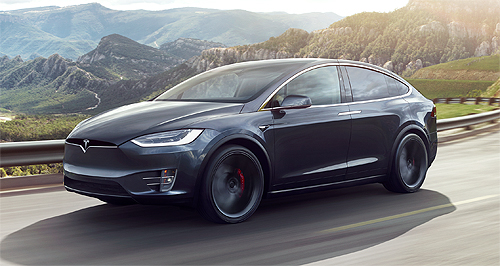Make / Model Search
News - General News - Electric VehiclesACT government to transition fleet to EVs by 2021EVs, roll out: The second-generation Nissan Leaf is one of the new EVs set to launch in Australia within the next 12 months. Electric-vehicle rollout accelerates in ACT as new action plan is announced16 Apr 2018 THE ACT government has announced a plan to accelerate the local adoption of pure-electric vehicles, including transitioning its entire fleet to zero-emission EVs by 2021 and allowing access to transit lanes. Under the Transition to Zero Emissions Vehicles Action Plan, the ACT will become emissions neutral by 2050 – a timeline that is consistent with the federal EV policy proposed by the Australian Greens last month. The first significant step in achieving this goal is the government committing to making at least half of the newly-leased vehicles in its fleet zero-emission by 2020, ahead of a complete transition by 2021. To prepare for this uptake, EV charging stations are set to be installed at ACT government buildings, while all new multi-unit and mixed-use developments will also be required to cater to EVs. Furthermore, the ACT government will consult with its NSW counterpart and local councils regarding the installation of EV charging stations on major roads, such as towards Sydney or coastal areas. Interestingly, hybrids and EVs will be able to be driven in ACT transit lanes from later this year to 2023, serving as another incentive for local motorists to purchase a zero-emission vehicle next. Despite its population of 400,000 people, less than 300 EVs are currently registered in the territory, but ACT climate change and sustainability minister Shane Rattenbury told The Canberra Times this will increase rapidly in the coming years. “If we put in an order for 600-odd vehicles over the next couple of years, that will be the largest electric-vehicle order in Australia ever seen so far,” he said. “If we as the government take the lead and bring those vehicles, in it will have the car manufacturers supply them more frequently, and it also means that as they come out of the leasing system there will be more second-hand cars available for the community in the next couple of years.” Costs generated by the plan will be mostly covered by existing budgets, however the outlay required for new EV charging stations is yet to be determined. The ACT government has pushed for the territory to only use renewable energy by 2020, meaning that vehicles will account for about 60 per cent of greenhouse gases emitted if this goal is met. ACT government staff will also be offered the chance to salary sacrifice for the purchase of an electric bike, with incentives to increase the uptake of such to be evaluated in due course. Electric Vehicle Council (EVC) chief executive officer Behyad Jafari congratulated the ACT government on its announcement, hoping that it will encourage increased EV uptake. “We welcome the commitment of 100 per cent of the government’s own new passenger-vehicle fleet being zero-emission vehicles by 2020/2021 where fit for purpose,” he said. “This will send a strong signal to the electric-vehicle industry to bring more models to market and provide flow-on benefits to consumers.” New-vehicle buyers who buy an EV in the ACT do not pay stamp duty and are subject to lower registration fees, which equate to savings of more than $2000 when the purchase price is $60,000. EVs currently available on the market include Tesla’s Model S and Model X, and BMW’s i3, while the Hyundai Ioniq, Nissan Leaf and Jaguar I-Pace are set to launch within the next 12 months. The ACT government has not indicated which vehicle or vehicles it will purchase for its fleet. Mr Jafari also indicated that the rollout of EVs will bolster the local economy, including the creation of new jobs. “The uptake of electric vehicles in the ACT is not only required to deliver on the territory’s emission-reduction targets, but it will also reduce the cost of transportation for residents,” he said. “The uptake of electric vehicles also presents great opportunities for the development of new businesses and jobs in Australia.” According to the EVC’s Recharging The Economy report, economic benefits of $2.9 billion could be reached by 2030, while 13,400 new jobs can be created. Meanwhile, motorists could save $1700 a year thanks to the lower costs of running an EV when compared to a vehicle powered by an internal-combustion engine. “The action plan also rightly targets electric-vehicle charging infrastructure,” Mr Jafari added. “Our surveys of consumer attitudes show that availability of charging infrastructure is a major barrier to uptake. “The ACT’s continued leadership on this issue is welcomed by the electric-vehicle industry and sets the benchmark for other governments to measure themselves against.”  Read more14th of March 2018  FCAI shares concerns over Greens federal EV policyWidespread electric vehicle adoption still faces several hurdles: Weber13th of March 2018  The Greens push for strict federal EV legislationFossil fuel ban, EV tax breaks, strict emission standards set under Greens proposal23rd of February 2018  SA in line to be first state to offer EV incentivesSA Labor promises five-years free rego and no stamp duty on EVs if re-elected19th of February 2018  BMW levels government for ‘short-sighted’ EV attitudeGovernment has to provide tax incentives, infrastructure for EV introduction: Werner7th of February 2018  EV take-up ‘to hit high gear soon’Local governments could help lead EV acceptance in Australia: Nissan15th of January 2018  Co-operation needed for EV adoption: governmentPreparation required as Australian EVs set to explode to one million over 12 years4th of January 2018  Vehicle CO2 emissions D-Day loomsMotor industry, federal government thrash out CO2 emissions cut target29th of November 2017  EVs need government support: NissanIntervention, incentives necessary to push EV adoption quickly according to Nissan13th of November 2017  Government necessary for EV uptake: BenzEV adoption ‘can’t happen without’ government according to Mercedes-Benz |
Click to shareGeneral News articlesResearch General News Motor industry news |











Facebook Twitter Instagram